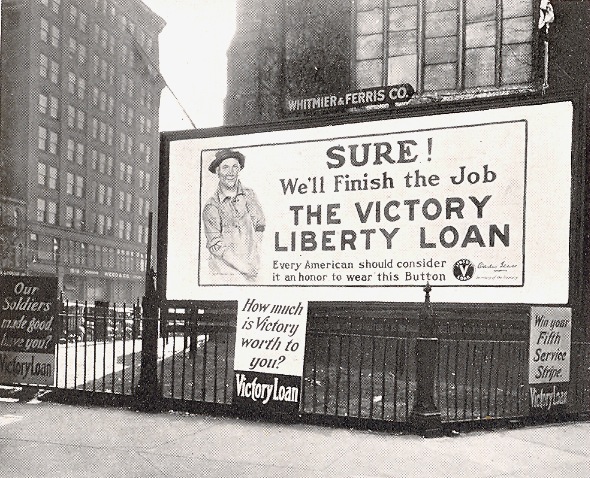
This solicitation for the Fifth Liberty Loan graced a billboard outside St. Paul’s Cathedral, near Shelton Square.
Author’s Collection
Machine Gunner Leonard W. Beck fell in action on June 7, 1918. On November 10, an exploding shell killed Marine Corps Lt. Oscar Swan on the banks of the River Meuse. These were the first and last Buffalonians to die in combat during the Great War. Many survivors returned wounded or maimed. Unfazed by or unaware of the great price the Nation would pay in blood and treasure over the next nineteen months, Western New Yorkers greeted news of the war with an outpouring of patriotic zeal.
On April 7, 1917, as President Woodrow Wilson prepared to sign the declaration of war he had requested five days earlier, and which was passed by Congress on April 6, every school in the city held a patriotic rally, raising the flag, singing the National Anthem and voicing three cheers for the President. By mid-afternoon, the Nation was officially at war, and Buffalonians reacted with enthusiastic patriotic demonstrations. The call went out to “put out the flag in every business place and home in Buffalo. In the coming weeks, numerous patriotic displays—rallies, mass public meetings, parades, etc.—would be held to show support for the government and to raise the community’s spirits. “Patriotic” meetings were organized in manufacturing plants, and schools were directed to hold patriotic celebrations to “recognize the gravity of the conditions confronting the country and to impress on students the importance of the President’s words.”
Call to Service
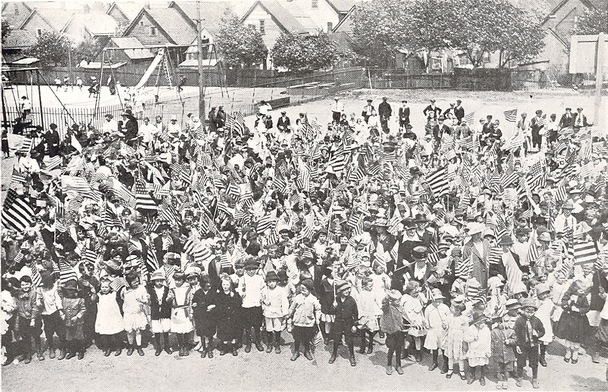
Buffalo school children gather on a playground, armed with American flags, to show support for the American entry into the First World War.
Author’s Collection
National Guard units mobilized quickly, as did Naval and Army Reserves. A draft was instituted to fill the ranks of a projected 2 million-man military force, and industrial production would be re-tooled into the “Armorer of Liberty.” The country thereby embarked on a period of fundamental change, taking it from isolation to world power. At the same time, an irrevocably changed America saw the beginnings of a population migration from farm to city. Many women would make the move from home to farms and industry, filling the vacuum left by departed “doughboys,” which also made room for increased participation by African-Americans in the life of the country.
Along with the rest of the nation, the Buffalo community responded positively to any summons to show their appreciation and respect for their men in uniform. As troop detachments departed for training camps and subsequent deployments, they were escorted by civic leaders, bands and hundreds of flag-waving supporters.
Buffalo’s location made it a major transit point for troops from across the country. The local Red Cross chapter operated a 24-hour canteen, offering hot coffee and sandwiches to soldiers passing through the city. For security reasons, train schedules were not announced in advance; however, the canteen prided itself on its ability to service a 3,000-soldier train on three hours’ notice. Bakeries in town ran on a 24-hour basis to meet canteen demands. Trains would stop for water and ice, during which time canteen personnel would carry food out to the trains. When weather permitted, hot showers were set up in the train yard.
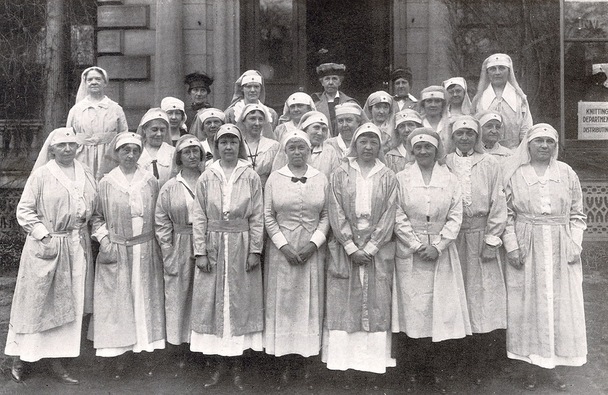
Some of the Station Canteen workers pose for a group photo, ca. 1917. The local Red Cross chapter operated the 24-hour canteen, offering hot coffee and sandwiches to soldiers passing through the city.
Author’s Collection
Newspapers across the country started a campaign to provide cigarettes and other sundries. The Buffalo News set up a “Smokes for Soldiers” campaign, urging smokers to skip smoking one day each week and donate the savings to the fund. One young girl even contributed her candy allowance. Special deliveries were made to Buffalo troops at their training camps. Eventually, supplies were sent to them at the Front.
Citizen Volunteers
As the armed forces mobilized, private citizens undertook their own mobilizations. Under leadership of major employers, Buffalo raised $1.5 million in support of a $100 million national Red Cross fund in aid of war relief efforts. 6,200 Pierce-Arrow workers signed up on a single day. By the war’s end, one-third of the nation’s population had become either volunteers or donors.
The Red Cross served as a vehicle for numerous other initiatives. In addition to volunteering to help run Buffalo’s railroad canteen, volunteers served as ambulance drivers, stretcher bearers and medical aides for front line aid stations. Others donated medical supplies, while at church women’s groups thousands of gauze bandages were rolled. Women’s clubs gathered to knit socks, sweaters, gloves and hats for those in the field.
Daughters of several prominent local families volunteered for service in Europe. Alice Lord O’Brien was part of a group of Smith College alumnae who served as ambulance drivers. Doris Kellogg started as a vehicle mechanic and later went on to hospital work. At war’s end, she was decorated by the French government for work managing canteens at French rail transit hubs. Her experiences generated wide interest through her memoir published after her return home. Banker George Rand offered at his own expense, to recruit and equip an infantry regiment of Western New Yorkers. The offer was not accepted, but President Wilson wrote “cordially thanking him” for his initiative.
The principal of Buffalo’s Technical High School offered the school’s machine shop as a munitions factory, which students would operate as a combined educational and patriotic exercise. The boys were capable of turning out 3-inch shell casings, small castings and machine parts. They could also be trained as inspectors in area manufacturing plants.
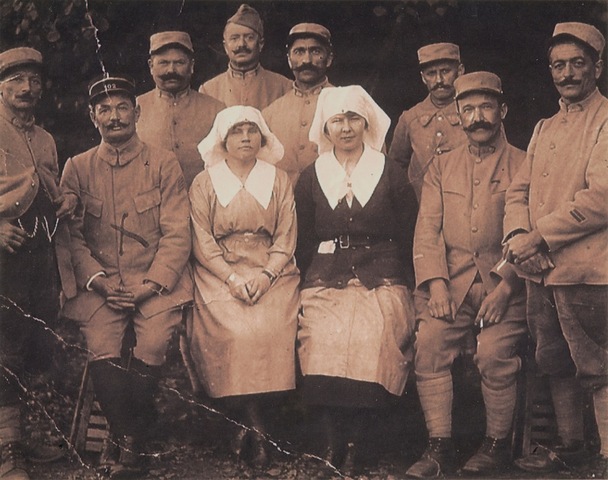
Doris Kellogg (at left center) poses among a group of French soldiers, 1917. At war’s end, she was decorated by the French government for work managing canteens at French rail transit hubs.
Courtesy Joan Miller
The war signaled the dawn of aerial combat, expanding the airplane’s role beyond reconnaissance. The War Department issued a call for volunteers to train pilots, hoping that 2,000 might be found in Western New York. The Buffalo Air Training Post was established at the Curtiss Aerodrome on Niagara Falls Boulevard, and local recruits were soon joined by aviator hopefuls from Yale, Harvard and The Ohio State University. A Volunteer Aerial Coast Patrol was organized and 12 Yale undergraduates were trained on two Curtiss flying boats, using a launch site on Porter Avenue.
Volunteer action of a different kind was undertaken by Polish-Americans seeking an independent Polish state if Poles heeded Tsar Nicholas’ promise and joined the war against Germany. They announced a plan to recruit a 100,000-man army which would fight as a unit, under its own officers. President Wilson refused to allow formation of such an autonomous entity within the Army; however, France was willing to finance the enterprise. Canada allowed a cadre of Polish officers to be trained in secret, providing a training venue named “Camp Kosciuszko” on the site of Butler’s Barracks at Niagara-on-the-Lake. 22,000 troops were trained and sent to fight with distinction in Flanders alongside French forces. They became known as the “Blue Army” on account of the color of their French-supplied uniforms.
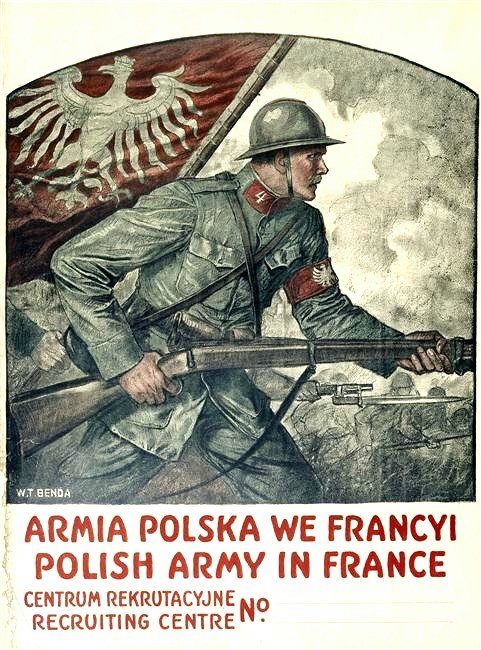
When President Wilson refused to allow such a formation on American soil, 22,000 Poles were trained at “Camp Kosciuszko” on the site of Butler’s Barracks at Niagara-on-the-Lake. Serving alongside French troops in Flanders, they became known as the “Polish Blue Army” on account of their blue French uniforms.
Courtesy Polish National Digital Archive
Enemies at Home
As troops prepared to head “over there,” rumors of spies and saboteurs threatening the homeland abounded. In Buffalo, a German agent possessing a dynamite-filled suitcase was arrested and accused of planning to blow up the Welland Canal. Chamber of Commerce president, Archer Landon, reported to its members that there was now “full confirmation” of rumors concerning “plots to cripple the country.” Alarmed by such reports, Buffalo’s civic leaders requested National Guard protection for railroads, vulnerable traffic points and vital utility facilities, including the electric generation facilities at Niagara Falls. In reaction to the scare, Buffalo obtained $2.5 million worth of “explosion” insurance to cover risks at the city’s pumping station, and the Erie County Sheriff confiscated privately-owned “ham” radio transmitters to limit the ability to coordinate offensive activities.
Alien and Sedition Acts were enacted to counter verbal or written subversion of the national effort. In the aftermath, many “hyphenated Americans” felt threatened. German-Americans comprised Buffalo’s largest ethnic community, but were largely either supportive of or silent on the subject of American policies. While most Western New Yorkers did not regard their Germanic neighbors as “the enemy,” many worried that those neighbors might become the subjects of discrimination.
Buffalo’s civic leaders, many of whom shared a German heritage, spoke out in support of their German-American bretheren. Lawyer and civic leader Adelbert Moot declared that he was “proud” that he had “German blood in his veins.” The war, he said, was not brought by the German people, but by “the Prussian autocracy.” Mayor Jacob Fuhrmann told a patriotic gathering that “Regardless of racial antecedents, there is and must be only one kind of Americans in America…Americans who are willing to make every sacrifice of life and treasure necessary in the common effort to uphold the integrity of our country.”
George Rand declared that many of his “warmest” friends were from the city’s German-American community, and that German-Americans comprised a substantial number of those interested in volunteering for the infantry regiment he had tried to assemble. When Buffalo’s German-American brewers were accused of harboring pro-German sentiments, the remainder of the city’s brewers stepped forward with an aggressive public relations effort in support of their competitors' patriotism.
Red Cross and Medical Services
In 1917, lacking legal authority to expand its capabilities, the Army Medical Corps was not equipped to meet the needs of an army in the field. The War Department turned for help to the Red Cross, requesting that the organization fund the organizing, equipping and staffing of 25 self-contained “Base” hospitals to care for battlefield wounded. Buffalo’s chapter was charged with raising $75,000 to pay for Base Hospital No. 23, to be organized at Fort Porter. Major alterations were made to accommodate the unit, as well as three other Base Hospital units from New York City, Philadelphia and Omaha. Civic leaders responded readily and soon achieved the goal. Meanwhile, a 303-member medical staff was recruited and trained to work as a cohesive unit. As an opportunity for “constructive patriotism,” the unit’s 28 doctors and 75 nurses served without pay prior to the hospital’s incorporation into the Army Medical Corps.
After training, Base Hospital No. 23 was assigned to a section of the French front, where they arrived on December 19. Designed as a 500-bed hospital, it was eventually expanded to 3,000 beds and, by war’s end, had treated 11,625 casualties and medical cases. The hospital wound up operations in February 1919, when remaining patients were transferred to French hospitals.
After the Base Hospitals vacated Fort Porter, the facility was reclassified as U.S. General Hospital No.4 which opened on November 10 to treat surgical cases. Three months later the hospital’s primary function became treatment of psychiatric cases, concentrating on “nervous” disorders, presumably the newly-recognized affliction of “shell shock” (which we know as PTSD). Eventually, “mental” cases were transferred to the Army hospital at Hampton, VA, which had superior facilities, after which the Fort Porter facility devoted itself to cases of “neuroses.”
Toward the end of the War, the Surgeon General of the Army selected Buffalo as site for one of its “Reconstruction Hospitals,” intended to prepare the gravely injured for return to private life, either through rehabilitation or, if that were not possible, through retraining for an occupation appropriate to their disability.
Food Will Win the War
The task of feeding the nation was an early priority of national planning efforts. Herbert Hoover, who had overseen European relief efforts, was placed in charge of food production and consumption. Challenges included feeding a greatly expanded army while continuing European relief shipments. Redirection of rail shipments in deference to transport of troops and war materiel further complicated matters.
Civilians were encouraged to increase food supplies by planting their own vegetable gardens. It was estimated that the average householder could grow sufficient vegetables in their “Liberty Gardens” to meet the needs of an average family. Newspapers provided seasonal planting guides and gardening advice, and a major public relations campaign stressed the importance of prudent choices and frugality at the dinner table.
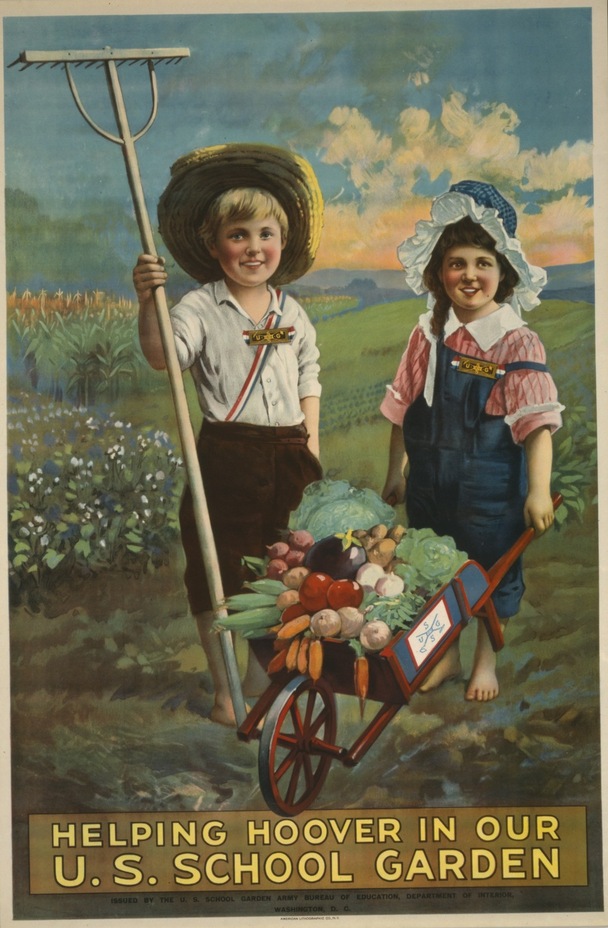
To augment the supply of food during the war, civilians—including school children—were encouraged to plant gardens on vacant lots, along railroad rights-of-way and in their own yards. Herbert Hoover was placed in charge of food production, and oversaw many of these efforts.
Library of Congress
In addition to individual gardens, Buffalo identified 4,270 acres of vacant land that could be used for community gardening. It was estimated that a $3,000,000 crop of potatoes could be grown on that land. An appeal was made to all who owned land within or outside the city to make it available for planting. Meat packing magnate Jacob Dold had the land surrounding his Middlesex Road residence plowed up and planted with potatoes. The Buffalo, Rochester & Pittsburgh and DL&W railroads offered land adjoining their rights of way to their employees who wished to plant a garden. Boy scouts could earn a merit badge for their garden plot. School children across the city were also encouraged to take part.
Rationing was never introduced, but citizens were taught to make changes in their diets, reduce portion sizes and waste, reducing domestic consumption by 15% while overseas shipments tripled. Beef and canned goods were exchanged for fish, pork and fresh vegetables. Beef was shipped overseas, while fewer canned goods meant reduced transportation costs and more metal for important war uses. Farmers were urged to plant wheat in place of oats, to ensure sufficient flour for baking bread for the troops and for export to Europe.
Lavish dinners and parties became unpatriotic. Restaurants were required to follow strict conservation guidelines, including prescribing portion sizes. Use of substitute ingredients in food preparation, particularly fats, sweeteners and grains was encouraged. Conservation was enhanced through “Meatless Mondays,” “Wheatless Wednesdays” and, later, a policy that discouraged driving on Sundays to save gasoline. Conservation also involved recovery of waste products, such as fats, which were used to make glycerine, a key ingredient in manufacture of explosives.
Ploughshares into Swords
A series of government-established oversight boards sought to harness industrial resources to the war effort. A War Industries Board suspended non-war-related production, reallocated raw materials and set production quotas and standards. A Fuel Administration prioritized the coal and gas requirements of industry, set prices and imposed severe conservation measures on private citizens. These were particularly painful for Buffalo during the unusually harsh winter of 1917. At one point, Toronto had more U.S. coal on hand than Buffalo, as manufacturers took advantage of the absence of price controls in Canada. The Railroad Administration diverted trains from routes traditionally used for agricultural shipments, disrupting national agricultural markets. In sum, this new regime facilitated Buffalo’s ascent to a major war production hub.
The Curtiss Aeroplane and Motor Corporation became the world’s largest aircraft manufacturer, producing over 10,000 aircraft during the war. To accommodate its new volume of work, the company engaged the Austin Corporation of Cleveland, an innovator in industrial buildings construction, to build a new plant on Elmwood Avenue. Austin promised to complete design and construction of the world’s largest aircraft factory, housing 30 acres under a single roof, within 120 days. The plant was completed thirty days early, and was so well constructed that it was still functional during World War II. [For more on Curtiss during WWI, see “Accept Everything America Can Produce” in the Fall 2015 issue of Western New York Heritage. Copies still available.]
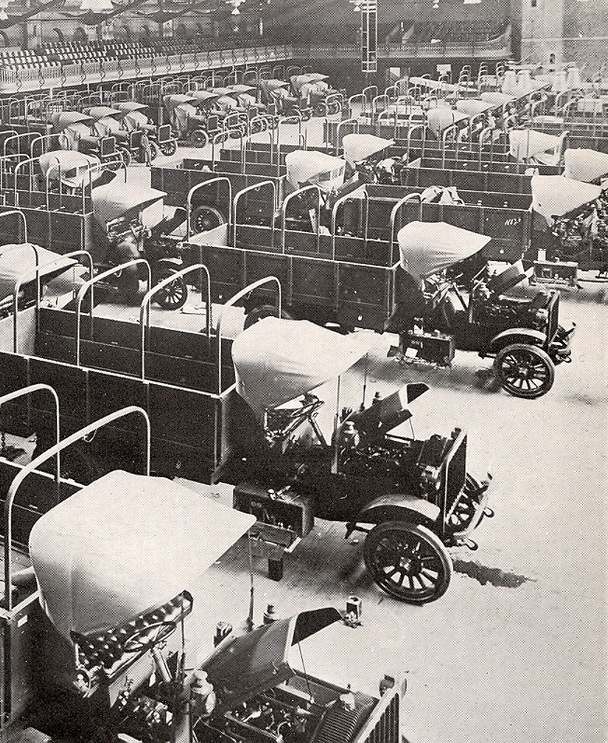
Dozens of Pierce-Arrow trucks are assembled inside the Broadway Auditorium, prior to being transported to New York City. In addition to trucks, the company also produced its design of a 12-cylinder Hispano-Suiza engine for planes in France.
Author’s Collection
The Pierce-Arrow Company’s 16,000 employees increased their production of military vehicles to supply the U.S. military as well as Britain and France. The company also produced its design of a 12-cylinder Hispano-Suiza engine for planes in France, which Curtiss later began installing in its own planes. Buffalo Pumps furnished units installed in American Liberty Ships. Without a design of its own, the U.S. Army began using British helmets before commissioning domestic production. The Crosby Company of Buffalo was one of eight firms selected to produce the pressed and stamped metal helmets, and produced 469,968 units by war’s end. The Oneida, Ltd. plant in Niagara Falls, Ontario (to be acquired years later by Buffalo China) produced ammunition clips, lead-plated gas shells, surgical instruments and combat knives.
Prior to the war, the world relied on precision optics supplied by Germany’s Zeiss firm, but the few domestic manufacturers able to match Zeiss’ quality could not meet wartime demands. The Bausch & Lomb Company of Rochester joined up with a chemist who had studied German manufacturing methods, and soon increased its production to 2,000 pounds of glass per day. The same chemist helped bring the technology to Buffalo’s Spencer Lens Company, which also began producing lenses. [For more on Spencer, see “Brass Beauties, Black Beauties: Buffalo’s Spencer Lens Company” in the Winter 2013 issue of Western New York Heritage. Copies still available.]
Another “innovation” of the First World War was the use of poison gas, and the Army was obliged to equip accordingly. Lacking a domestic source, they turned to Western New York’s National Aniline and Dye Co. to produce chlorine, phosgene and mustard gas. Once operating at capacity, the plant was producing 50 tons of gas per day (German plants had never managed to produce more than 6 tons per day).
Beat the Hun with Bonds
Wartime expenditures dwarfed the nation’s peacetime spending, eventually costing over $30 billion, including loans to Britain and France. Approximately one-half of the war’s cost was financed by the sale of “Liberty Loan Bonds,” marketed aggressively to the public in patriotic campaigns, cleverly asserting as a moral equivalency: “Fight, Or Buy Bonds!”
Bond denominations ranged from $50 to $100,000, and 25-cent “Thrift Stamps” were offered to those of lesser means; $50 in thrift stamps could be traded in for a full bond. The bonds came with lower interest rates and longer terms than offered by banks, discouraging those holding large portfolios from trading existing investments for Liberty Bonds, preventing chaos in money markets.
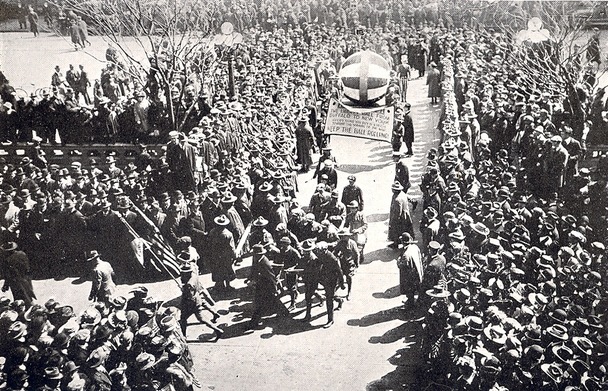
To kick off the First Liberty Loan campaign, a “Liberty Ball” was rolled from Buffalo City Hall to New York City, encouraging each town along the way to “keep the ball rolling” with their contributions.
Author’s Collection
Five series of bonds were issued from May 1917 through May 1919, each having its own campaign from three to six weeks. Public officials and stars of stage and screen crisscrossed the country to drum up sales. Meetings were held in venues ranging from industrial plants to church halls, while “Four Minute Men” gave brief exhortations at Buffalo’s theaters and movie houses, all firmly urging attendees to buy bonds.
Sales quotas were assigned to each Federal Bank region, but goals were set with less formality at the local level. Of the $22.5 billion total goal, Buffalo’s aggregate target came to $194 million, which was exceeded by $32 million.
Meanwhile . . .
Though war brought enormous changes to everyday life in Buffalo, some aspects continued, seemingly unaffected by events in Europe. For example, newspapers in the fall of 1918 advertised a wide range of popular entertainment at local venues – motion pictures, plays, operatic recitals, vaudeville shows and the like.
Along with the rest of the country, area sports teams lost key team members to national service. The 74th Infantry baseball team withdrew from its league in anticipation of the unit’s mobilization, while Buffalonians avidly followed a series of prize fights at the Broadway Auditorium featuring Willie “Kayo” Brennan, “Buck” Crouse and the dark-skinned Italian “Zulu Kid.”
In March 1918, the Buffalo State Normal School was dedicated, and in May the Federal Reserve Board opened a local branch of the Bank. That same month, President Wilson signed legislation creating the first air postal service, with a Curtiss “Jenny” gracing the first airmail stamp. Defining women’s suffrage as a partisan issue, its discussion was barred from public schools, while New York Telephone Company operators ceased responding to requests for the “time of day,” deeming it an unnecessary service.
In September, the Spanish Influenza pandemic reached Buffalo. In an effort to stem the spread of the disease, Mayor Buck banned public funerals and gatherings of more than 10 persons. Industrial workers were required to wear masks. On October 13, the Buffalo Courier reported that the city was experiencing a shortage of doctors and nurses to deal with the crisis. Retired nurses were urged to return to hospitals, and junior and senior students from the Buffalo Medical School were called in. As the crisis worsened, sophomores were pressed into service.
Peace
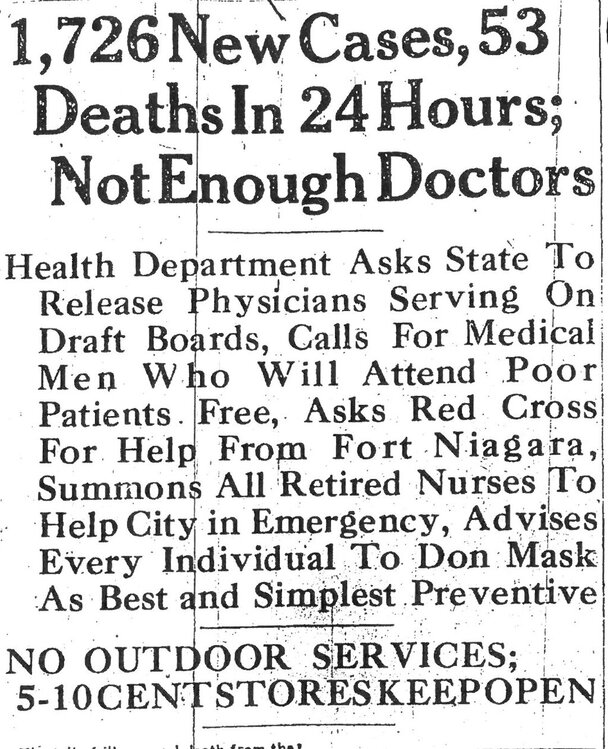
The October 13, 1918 edition of the Buffalo Courier reported the shortage of doctors and other medical personnel, due to the influenza pandemic that gripped Buffalo and the nation as the war came to a close.
Courtesy University of Michigan Center for the History of Medicine
On the morning of November 10, word spread across the city like wildfire that the war was over. Workers poured out of plants, stores and offices in spontaneous celebrations from one end of town to the other. As the throngs in the streets became unmanageable, news bulletins reported the error; the German High Command was merely reviewing a draft of the proposed surrender document. Undeterred, the crowds celebrated late into the evening.
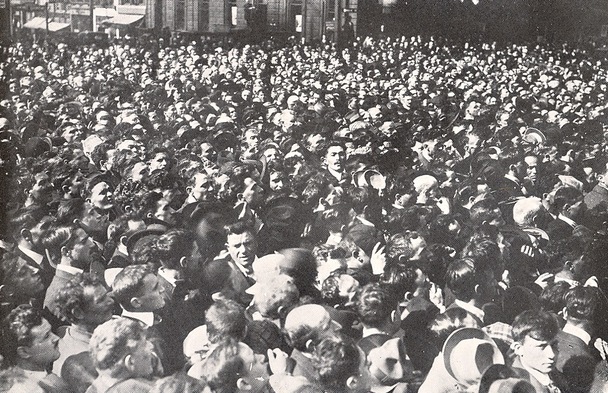
Jubilant Buffalonians crowd the streets to celebrate, following the erroneous announcement of peace on November 10, 1918. The city would witness a second such celebration following the real armistice a day later.
Author’s Collection
The following day brought an official end to hostilities. As if energized by a second wind, the jubilation revived. “Buffalo began to whoop it up for peace again,” crowed one newspaper. Another reported, “All the rollicking, roistering, reveling, raucous methods of rejoicing were repeated.” Crowds set upon cars that were not displaying the flag. “Streets throbbed with patriotism as people, laying usual duties aside, joined in great holiday jollification.” It was “the most prolonged period of hilarious rejoicing Buffalo ever experienced.” A multitude of parades and public gatherings followed, and churches were filled for services of thanksgiving.
During the war, retailers struggled to overcome the dual handicaps of reduced inventory and the diminished means of their customers. However, as soon as news of the Armistice arrived, merchants responded with aggressive “Victory” sales campaigns to draw back customers. In retrospect, some of those efforts may have been a touch over-aggressive: The day after the guns fell silent on the Western Front, Desbecker’s men’s clothier (349-351 Main Street) trumpeted in the Buffalo Courier: “WAR ENDED - Now Buy Suits and Overcoats.”
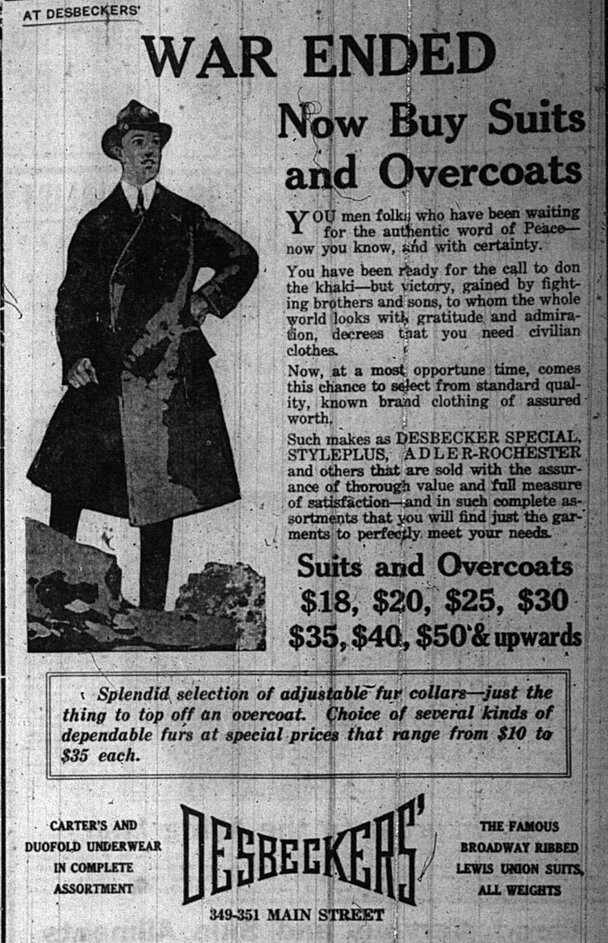
Desbecker’s men’s clothier ran this ad in the Buffalo Courier on November 12, 1918.
Credit- Courtesy Buffalo and Erie County Public Library
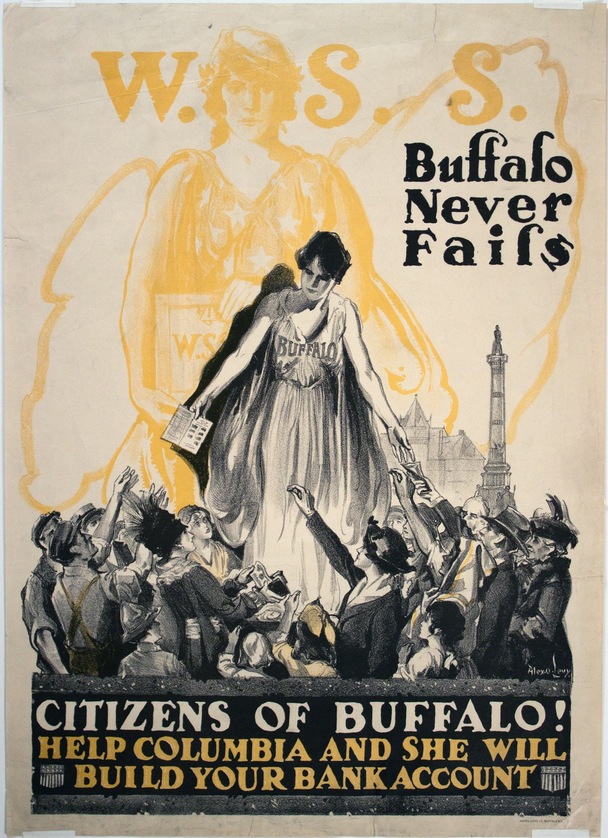
Poster promoting the sales of War Savings Stamps, and featuring the slogan “Buffalo Never Fails,” which was created during the Third Liberty Loan and heavily used during the fourth. This poster will be among the evocative items on display at the Buffalo and Erie County Public Library, as part of their exhibit: Buffalo Never Fails: The Queen City and World War I. The exhibit will run from November 2017 to January 2020.
Courtesy Buffalo and Erie County Public Library










